What would your future-you have to say to you?
The no-pants guide to spending, saving, and thriving in the real world.
What would your future-you have to say to you?
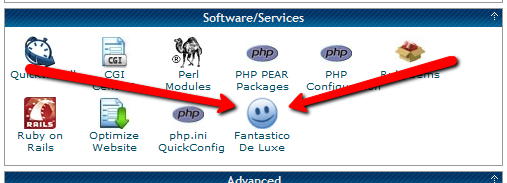
In this installment of the Make Extra Money series, I’m going to show you how to set up a WordPress site. I’m going to show you exactly what settings, plugins, and themes I use. I’m not going to get into writing posts today. That will be next time.
I use WordPress because it makes it easy to develop good-looking sites quickly. You don’t have to know html or any programming. I will be walking through the exact process using Hostgator, but most hosting plans use CPanel, so the instructions will be close. If not, just follow WordPress’s 5 minute installation guide.
Assuming you can follow along with me, log in to your hosting account and find the section of your control panel labeled “Software/Service”. Click “Fantastico De Luxe”.

On the Fantastico screen, click WordPress, then “New Installation”.
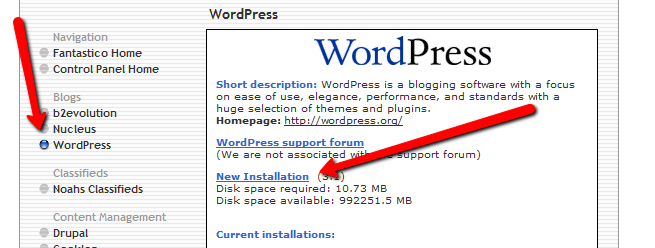
On the next screen, select your domain name, then enter all of the details: admin username, password, site name, and site description. If you’ll remember, I bought the domain http://www.masterweddingplanning.net. I chose the site name of “Master Wedding Planning” and a description of “Everything You Need to Know to Plan Your Wedding”.
Click “install”, then “finish installation”. The final screen will contain a link to the admin page, in this case, masterweddingplanning.net/wp-admin. Go there and log in.
After you log in, if there is a message at the top of the screen telling you to update, do so. Keeping your site updated is the best way to avoid getting hacked. Click “Please update now” then “Update automatically”. Don’t worry about backing up, yet. We haven’t done anything worth saving.
Next, click “Settings” on the left. Under General Settings, put the www in the WordPress and site URLs. Click save, then log back in.
Click Posts, then Categories. Under “Add New Category”, create one called “Misc” and click save.
Click Appearance. This brings you to the themes page. Click “Install Themes” and search for one you like. I normally use Headway, but before I bought that, I used SimpleX almost exclusively. Your goal is to have a simple theme that’s easy to maintain and easy to read. Bells and whistles are a distraction.
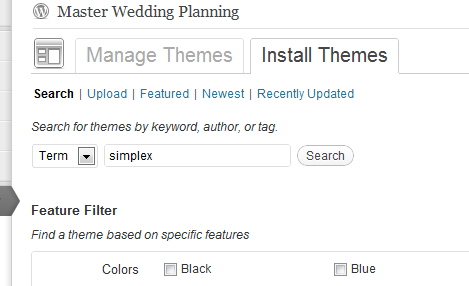
Click “Install”, “Install now”, and “Activate”. You now have a very basic WordPress site.
A plugin is an independent piece of software to make independent bits of WordPress magic happen. To install the perfect set of plugins, click Plugins on the left. Delete “Hello Dolly”, then click “Add new”.
In the search box, enter “plugin central” and click “Search plugins”. Plugin Central should be the first plugin in the list, so click “install”, then “ok”, then “activate plugin”. Congratulations, you’ve just installed your first plugin.
Now, on the left, you’ll see “Plugin Central” under Plugins. Click it. In the Easy Plugin Installation box, copy and paste the following:
All in One SEO Pack Contact Form 7 WordPress Database Backup SEO SearchTerms Tagging 2 WP Super Cache Conditional CAPTCHA for WordPress date exclusion seo WP Policies Pretty Link Lite google xml sitemaps Jetpack by WordPress.com
Click “install”.
On the left, click “Installed Plugins”. On the next screen, click the box next to “Plugins”, then select “Activate” from the dropdown and click apply.
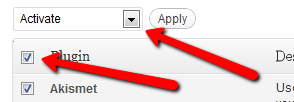
Still under Plugins, click “Akismet Configuration”. Enter your API key and hit “update options”. You probably don’t have one, so click “get your key”.
The only tool I worry about is the backup. It’s super-easy to set up. Click “Tools”, then “Backup”. 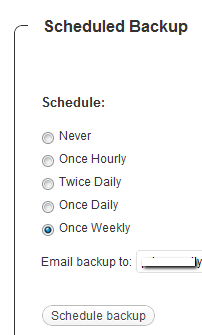
Scroll down to “Schedule Backups”, select weekly, make sure it’s set to a good email address and click “Schedule Backup”. I only save weekly because we won’t be adding daily content. Weekly is safe enough, without filling up your email inbox.
There are a lot of settings we’re going to set. This is going to make the site more usable and help the search engines find your site. We’re going to go right down the list. If you see a section that I don’t mention, it’s because the defaults are good enough.
Set the Default Post Category to “Misc”.
Visit this page and copy the entire list into “Update Service” box. This will make the site ping a few dozen services every time you publish a post. It’s a fast way to get each post indexed by Google.
Click “Save Changes”.
Uncheck everything under “Email me whenever…” and hit save. This lets people submit comments, without actually posting the comments or emailing me when they do so. Every once in a while, I go manually approve the comments, but I don’t make it a priority.
Select “Custom structure” and enter this: /%postname%/
Click save.
Set the status to “Enabled”, then fill out the site title and description. Keep the description to about 160 characters. This is what builds the blurb that shows up by the link when you site shows up in Google’s results.
Check the boxes for “Use categories for META keywords” and “Use noindex for tag archives”.
Click “Update Options”.
Check the boxes to remove each of the dates and set the alt text to “purpose” or something. This will suppress the date so your posts won’t look obsolete.
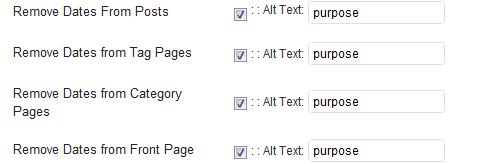
This plugin reinforces the searches that bring people to your site. It’s kind of neat. Skip the registration, accept the defaults and hit save.
Scroll to the bottom and click import. We’ll come back to this.
Select “Caching On” and hit save.
Across the top of the screen should be a giant banner telling you to connect to WordPress.com and set up Jetpack. You’ll need an account on WordPress.com, so go there and set one up. After authorizing the site, you’ll be brought back to the Jetpack configuration screen. Click “Configure” under “WordPress.com Stats”. Take the defaults and hit save.
On the contact configuration page, copy the code in the top section. You’ll need this in a moment.
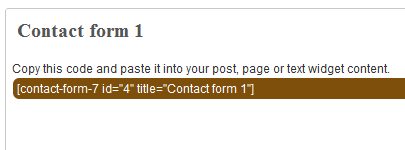
Now, we going to create a couple of static pages. On the left, click “Pages”, then “Add new”.
Name the first page “Contact” and put the contact form code in the body of the page. Hit publish.
Under Appearance, click “Menu”. Enter a menu name and hit save.
Then, under “Pages”, click the box next to “Contact”, “Disclaimer”, and any other policies you’d like to display. Hit save.
Also under Appearance, click “Widgets”. This is where you’ll select what will display in the sidebar. All you have to do is drag the boxes you want from the middle of the page to the widget bar on the right. I recommend Text, Search, Recent Posts, Popular Search Terms and Tag Cloud. In the text box, just put some placeholder text in it, like “Product will go here”. We’ll address this next time.
We’re not going to worry about getting posts in place, yet. That will be the next installment. However, the steps in the next installment could take 2 weeks to implement, and we want Google to start paying attention now. To make that happen, we need to get a little bit of content in place. This won’t be permanent content. It’s only there so Google has something to see when it comes crawling.
To get this temporary, yet legal content, I use eZineArticles. Just go search for something in your niche that doesn’t look too spammy.
Then, click “Posts”, then delete the “Hello World” post. Click “Add new”. Copy the eZine article, being sure to include the author box at the bottom, and hit publish.
To see your changes, you may have to go to Settings, then WP Cache and delete the cache so your site will refresh.
Congratulations! You now have a niche blog with content. It’s not ready to make you any money, yet, but it is ready for Google to start paying attention. In the next installment, I’ll show you how I get real unique content and set it up so Google keeps coming back to show me the love.

I’m a debtor.
I’d like that to be otherwise, but I’m pretty close to the limit of what I can do to change that. Don’t get me wrong, it’s changing, but there is a limit to how many side projects I can take on at one time. So, I’m in debt and likely to stay that way for the next couple of years.
As part of my budget, I set up a few categories of items that are either necessities or “really wants” without being immediate expenses. For example, I’m setting aside some money each month for car repairs, even though my car isn’t currently broken. When it comes time to fix something, I hope to have the money available to fix it, without having to scramble or <spit> tap into my emergency fund.
All told, I have about a dozen of these categories set up, each as a separate INGDirect savings account. Twice a month, a few hundred dollars gets transferred over and divided among the savings goals. Most of these goals are short-term; they will be spent within the year, like the account for my property taxes. Some of them are open-ended, like my car repair fund. Some are open ended, but will eventually end, like the fund to finance my son’s braces. All of the accounts are slowly growing.
As I’ve watched the progress of my savings accounts, I’ve noticed something funny.
It may only be a few thousand dollars, but it’s more money than I have ever had saved. The vast majority of this money will be spent over the next few years, but having it there, now means that I have tomorrow covered. For the first time in my life, I’m not living paycheck to paycheck. No matter what happens, I know I can make ends meet for a couple of months. That fact alone has reduced my stress level more than I could have imagined.
Two years ago, I was sure I was going to file bankruptcy. Now, I’m looking at being just two years away from having all of my debt gone. I have faith that my future will be bright, and only getting brighter. If I can dig myself out of this hole once, I can do it again, no matter what happens.
This has brought a calm that I can’t easily explain. I don’t have to worry about where next week’s groceries are going to come from, or how we’re going to afford braces in a couple of years.
Having an emergency fund and some auxiliary funds has been entirely worth the work we’ve done for last two years. Have you noticed any changes as you pay off your debt and build savings?
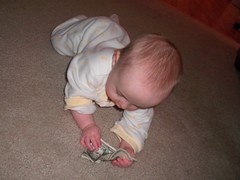
Ten years ago, I buried myself in debt. There was no catastrophic emergency or long-term unemployment, just a series of bad decisions over the course of years.
We bought a (short) series of new cars, a house full of furniture, electronics, hundreds of books and movies, and so much more. We threw a wedding on credit and financed an addition on our house. We didn’t gamble or drink it away, we just spent indiscriminately. We have a ton of stuff to show for it and a peeling credit card to prove it.
What changed?
In October 2007, we found out brat #3 was on the way. Don’t misunderstand, this was entirely intentional, but our…efficiency caught us by surprise. It took several years to get #2. We weren’t expecting #3 to happen in just a couple of weeks. #2 wasn’t even a year old when we found out she was going to be a big sister. That’s two kids in diapers and three in daycare at the same time.
The technical term for this is “Oh crap”.
I spent weeks poring over our expenses, trying to find a way to make our ends meet, or at least show up in the same zip code occasionally.
I finally made my first responsible financial decision…ever. I quit smoking. At that point, I had been smoking a pack a day or more for almost 15 years. With the latest round of we’re-going-to-raise-the-vice-tax-to-convince-people-to-drop-their-vices-then-panic-when-people-actually-drop-their-because-we-made-them-too-expensive taxes, I was spending at least $60 per week, at least.
Interesting side story: A few years ago, Wisconsin noticed how many Minnesotans were crossing the border for cheap smokes and decided to cash in by raising their cigarette taxes. The out-of-state market immediately dried up. Econ 101.
So I quit, saving $250 per month.
Our expenses grew to consume that money, which we were expecting. (Remember, we were expecting a baby!) Unfortunately, our habits didn’t change. We still bought too much, charged too much on our credit cards, and used our overdraft protection account every month. At 21% interest!
Nothing else changed for another year and a half. My wife would buy stuff I didn’t like and we’d fight about it. I’d buy stuff she didn’t like and we’d fight about it. When we weren’t arguing about it, we’d just silently spend it all as fast as we could.
Bankruptcy was looming. We had $30,000 on our credit cards and our overdraft protection account was almost maxed out. Have you ever thought you’d have to sell your house quickly?
One day, while I was researching bankruptcy attorneys, I ran across Dave Ramsey. When I got to daycare that evening to pick up the kids, I noticed they had The Total Money Makeover on the bookshelf, so I asked to borrow it.
I read the book twice, had a very frank discussion with my wife about the possibility of bankruptcy, and we set out on the path to financial freedom together.
What made you decide to handle your finances responsibly? Or, perhaps more importantly, what’s holding you back?
When you accumulate a certain level of debt, it feels like you’re wading through an eyeball-deep pool of poo, dancing on your tiptoes just to keep breathing. Ask me how I really feel.
It shouldn’t be a surprise that I’m in debt. We have gone over this before. The story isn’t one of my proudest, so I’ve never talked much about how it happened.
Our debt was entirely our fault. We messed up and dug our own poo-pool. There were no major medical bills, no extended unemployment, just a strong consumer urge and an apparent need for instant gratification. Delayed gratification wasn’t a skill I’d considered learning. The idea of it was a thoroughly foreign concept. Why wait when every store we visited offered no payments/no interest for a year? We didn’t give much thought to what would happen when the year was up.
We got married young. We bought our house young. We started our family young. We did all of that over the course of two years, well before we were financially ready. Twenty years old, we had excellent credit and gave our credit reports a workout. Credit was so easy to get. By the time I was 22, we had a total credit limit more than twice our annual income. We fought so hard to keep up with the Joneses. A new pickup, a remodel on our house. Within a month of paying off the truck, I got a significant raise and rushed out to buy a new car.
Every penny that hit the table was caught in a net of lifestyle expansion. I was bouncing on my tiptoes.
Four months into my new car payment, I was laid off. There’s me, hoping for a snorkel. A week later, we found out our son was going to be a big brother. Our pool had developed a tide.
We killed the cable and cut back on everything else and…managed. Money was tight, but we got by. I got a new job, but had we learned any lessons? Of course not. We got a satellite dish, started shopping the way we always had. Times were good, and could never be bad. We had such short memories.
Fast forward a couple of years. Baby #3 is on the way while baby #2 is still in diapers. Daycare was about to double. Daddy started to panic. I built a rudimentary budget and realized there was no way to make ends meet. There just wasn’t enough cash coming in to cover expenses. That’s when I made my first frugal decision: I quit smoking. That cut the expenses right to the level of our income. It was tight, but doable.
There was still one serious problem. Neither one of us could control our impulse shopping. For a time, I was getting packages delivered almost every day. It was never anything expensive, but it was always something. Little things add up quickly.
Last spring, I realized we couldn’t keep going like that. I started looking into bankruptcy. Somehow, we managed to toss ourselves into the deep end of the pool. We had near-perfect credit and no way to maintain it.
While researching bankruptcy, I found our life preserver. We put together a budget. We cut and…it hurt. It’s taken a year, but every bill we have is finally being tracked. We have an emergency fund and we are working towards our savings goals. It hasn’t been an easy year, but we are making progress. We’ve eliminated 15% of our debt and opened out budget to include some “blow money” and an occasional date night. We are always looking for ways to decrease our bottom line and increase the top line. Most important, we are actually working together to keep all of our expenses under control, with no hurt feelings when we remind ourselves to stay on track.
We are finally standing flat-footed, head and shoulders above the poo.
Update: This post has been included in the Carnival of Personal Finance.
“Walk on road, hm? Walk left side, safe. Walk right side, safe. Walk middle, sooner or later, [makes squish gesture] get squish just like grape. Here, karate, same thing. Either you karate do “yes”, or karate do “no”. You karate do “guess so”, [makes squish gesture] just like grape. Understand?” -Mr. Miyagi
It occurred to me that lately, I’ve changed my day-to-day cash flow plans a couple of times.
A year ago, I was running on a fairly strict cash-only plan.
A month ago, I was running on a strict budget, but doing it entirely out of my checking account.
Now, I’m loosening the budget reins, and moving all of my payments and day-to-day spending to a credit card, including a new balance that I can’t immediately pay off.
The thing is, changing plans too often scares me. Like the quote at the beginning of this post, I start worrying about being squished like a grape.
The simple fact is that any plan will work.
If you want to get out of debt, just pick a plan and run with it. If that means you follow Dave Ramsey and do the low-balance-first debt snowball, good for you. Do it. If you follow Suze Ormann and do a high-interest first repayment plan, great. Do it. If you follow Bach and pay based on a complicated DOLP formula to repay in the quickest manner, wonderful! Do it!
Just don’t switch plans every month. If you do that, you’ll lose momentum and motivation. Squish like grape! Just pick a plan and go. It really, truly does not matter which plan you are following as long as you are following through.
This applies to other parts of your life, too. For example, there are a thousand fad diets out there. Here’s a secret: they all work. Every single one of them, whether it’s Weight Watchers, slow carb, or the beer-only diet. The only thing that matters is that you stick to the diet. If you manage that, you will lose weight on any diet out there. Except for the jelly bean and lard diet. That one will make you extra soft.
Another secret: the productivity gurus are right. Every single one of them. David Allen, Stephen Covey, Steve Pavlina, and the rest. They all have the One True Secret to getting the most out of your day. Really. Pick a guru and go! But don’t try to Get Things Done in the morning and do 7 Habits at night. Changing systems, changing plans, changing your mind will make you sabotage yourself.
The real secret to accomplishing great things, whether it’s paying off $100,000 of debt, dropping 40 pounds in 3 months, or tripling your productivity is to do it. Just get started and, once you’ve started, don’t stop. If you keep going and stay consistent, you’ll accomplish more than anyone who hops from system to system every few weeks.